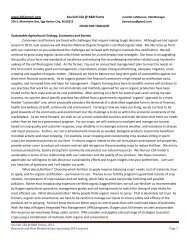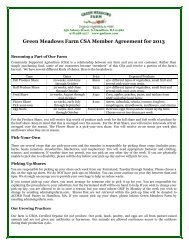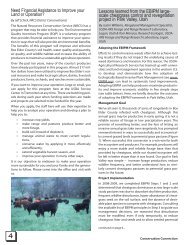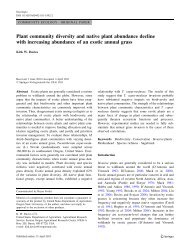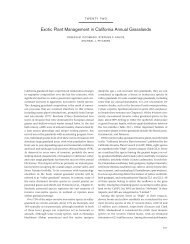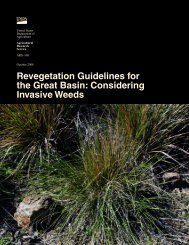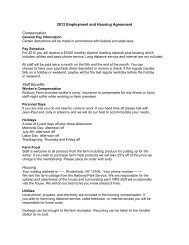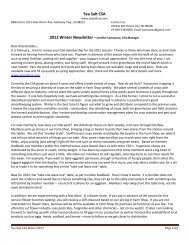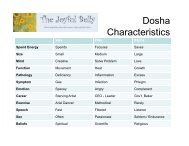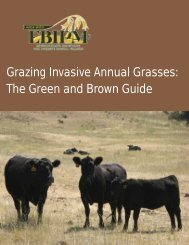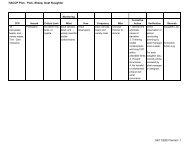Rangeland health attributes and indicators for qualitative assessment
Rangeland health attributes and indicators for qualitative assessment
Rangeland health attributes and indicators for qualitative assessment
Create successful ePaper yourself
Turn your PDF publications into a flip-book with our unique Google optimized e-Paper software.
Table 1. St<strong>and</strong>ard <strong>indicators</strong> included in the rangel<strong>and</strong> <strong>health</strong> protocol, <strong>attributes</strong> to which each indicator applies, <strong>and</strong> publications used to develop the<br />
descriptors <strong>and</strong> interpretations <strong>for</strong> each indicator.<br />
Indicators <strong>and</strong> brief descriptions of characteristics <strong>for</strong> Attributes Relevant Literature<br />
evaluating the indicator Soil <strong>and</strong> Hydrologic Biotic<br />
Site Function Integrity<br />
Stability<br />
1. Rills – the frequency <strong>and</strong> spatial distribution of linear X X Quansah 1985, Morgan <strong>and</strong> Davidson 1986, Bryan 1987<br />
erosional rivulets.<br />
2. Water Flow Patterns – the amount <strong>and</strong> distribution of X X Morgan <strong>and</strong> Davidson 1986, Tiscareño Lopez et al. 1993<br />
overl<strong>and</strong> flow paths that are identified by litter distribution<br />
<strong>and</strong> visual evidence of soil <strong>and</strong> gravel movement.<br />
3. Pedestals <strong>and</strong>/or Terracettes – the frequency <strong>and</strong> X X Anderson 1974, Morgan <strong>and</strong> Davidson 1986, Satterlund<br />
distribution of rocks or plants where soil has been eroded <strong>and</strong> Adams 1992, Hudson 1993<br />
from their base (pedestals) or areas of soil deposition<br />
behind obstacles.<br />
4. Bare Ground – size <strong>and</strong> connectivity among areas of soil X X Smith <strong>and</strong> Wischmeier 1962, Anderson 1974, Gould<br />
not protected by vegetation, biological soil crusts, litter, 1982, Morgan <strong>and</strong> Davidson 1986, Benkobi et al. 1993,<br />
st<strong>and</strong>ing dead vegetation, gravel or rocks. Blackburn <strong>and</strong> Pierson 1994, Pierson et al. 1994,<br />
Spaeth et al. 1994, Gutierrez <strong>and</strong> Hern<strong>and</strong>ez 1996,<br />
Puigdefábregas <strong>and</strong> Sánchez 1996, Weltz et al. 1998,<br />
Cerda 1999<br />
5. Gullies –amount of channels cut into the soil <strong>and</strong> the X X Anderson 1974, Morgan <strong>and</strong> Davidson 1986,<br />
amount <strong>and</strong> distribution of vegetation in the channel. Martin <strong>and</strong> Morton 1993<br />
6. Wind Scoured, Blowouts <strong>and</strong>/or Deposition Areas – X Chepil 1945, Chepil <strong>and</strong> Woodruff 1963, Anderson 1974,<br />
frequency of areas where soil is removed from under<br />
Gillette et al. 1974, Gillette <strong>and</strong> Walker 1977, Gibbens et<br />
physical or biological soil crust or around vegetation<br />
al. 1983, Hennessy et al. 1983, Hagen 1984, Hennessy et<br />
OR frequency of accumulation areas of soil associated al. 1986, Morgan <strong>and</strong> Davidson 1986, Pye 1987<br />
with large structural objects, often woody plants.<br />
7. Litter Movement – frequency <strong>and</strong> size of displaced litter X Thurow et al. 1988<br />
by wind <strong>and</strong> overl<strong>and</strong> flow of water.<br />
8. Soil Surface Resistance to Erosion – ability of soils to resist X X X Bond <strong>and</strong> Harris 1964, Belnap <strong>and</strong> Gardner 1993,<br />
erosion through the incorporation of organic material into soil Blackburn et al. 1992, Morgan <strong>and</strong> Davidson 1986,<br />
aggregates. It is evaluated by using a modified slake test.<br />
Goff et al. 1993, Blackburn <strong>and</strong> Pierson 1994, Fryrear et<br />
al. 1994, Pierson et al. 1994, Morgan et al. 1997,<br />
Belnap <strong>and</strong> Gillette 1998, Herrick et al. 2001<br />
9. Soil Surface Loss or Degradation – frequency <strong>and</strong> size of X X X Hennessy et al. 1986, Warren et al. 1986, Satterlund <strong>and</strong><br />
areas missing all or portions of the upper soil horizons that Adams 1992, O’Hara et al. 1993, Karlen <strong>and</strong> Stott 1994,<br />
normally contain the majority of organic material of the site.<br />
Wood et al. 1997, Davenport et al. 1998, Dormaar <strong>and</strong><br />
Willms 1998<br />
10. Plant Community Composition & Distribution Relative to X Blackburn 1975, Wood <strong>and</strong> Blackburn 1984,<br />
Infiltration & Runoff – the community composition or Johnson <strong>and</strong> Gordon 1988, Thurow et al. 1988,<br />
distribution of species that restrict the infiltration of water Blackburn <strong>and</strong> Wood 1990, Schlesinger et al. 1990,<br />
on the site. Blackburn et al. 1992<br />
11. Compaction Layer – thickness <strong>and</strong> distribution of the X X X Barnes et al. 1971, Webb <strong>and</strong> Wilshire 1983, Willat <strong>and</strong><br />
structure of the soil near the soil surface (=< 15 cm) Pullar 1983, Cole 1985, Blake <strong>and</strong> Hartge 1986,<br />
Warren et al. 1986, Wallace 1987, Thurow et al. 1988,<br />
Hassink et al. 1993, Larson <strong>and</strong> Pierce 1993, Chanasyk<br />
<strong>and</strong> Naeth 1995, Hillel 1998<br />
12. Functional/Structural Groups – the number of groups, X Chapin 1993, Dawson <strong>and</strong> Chapin 1993, Solbrig et al.<br />
the number of species within groups, or the rank of order 1996, Tilman et al. 1997<br />
of dominance of groups.<br />
13. Plant Mortality/Decadence – frequency of dead or X Stoddard et al. 1975, Pyke 1995,<br />
moribund (dying) plants<br />
14. Litter Amount – deviation in the amount of litter. X X Thurow et al. 1988, Whit<strong>for</strong>d 1988, Whit<strong>for</strong>d 1996,<br />
Hester et al. 1997<br />
15. Annual Abroveground Production – amount relative X Cooper 1975, Whittaker 1975, Rickard <strong>and</strong> Rogers 1988,<br />
to the potential <strong>for</strong> that year based upon the climate. Tilman <strong>and</strong> Downing 1994<br />
16. Invasive Plants – abundance <strong>and</strong> distribution of X Lacey et al. 1990, Olson 1999, Stohlgren et al. 1999<br />
invasive plants regardless if they are noxious weeds,<br />
exotic species, or native plants whose dominance greatly<br />
exceeds that expected at the ecological site.<br />
17. Reproductive Capability of Perennial Plants – evidence X Hanson <strong>and</strong> Stoddard 1940, Mueggler 1975, Harper 1977,<br />
of the inflorescences or of vegetative tiller production White 1979<br />
relative to the potential based upon the current climate.<br />
JOURNAL OF RANGE MANAGEMENT 55(6) November<br />
587



